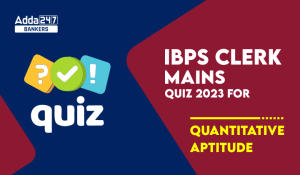Dear Students,
Quantitative Aptitude Section has given heebie-jeebies to the aspirants when they appear for a banking examination. As the level of every other section is only getting complex and convoluted, there is no doubt that this section, too, makes your blood run cold. The questions asked in this section are calculative and very time-consuming. But once dealt with proper strategy, speed, and accuracy, this section can get you the maximum marks in the examination. Following is the Quantitative Aptitude quiz to help you practice with the best of latest pattern questions.
Following the study plan for SBI PO Preliminary Examination 2018, the fifth week starts with practice questions on Miscellaneous Questions Set. To ensure proper preparation of the section we advise you to go through all the questions sincerely and try to attempt each one of them. Afterward, match your solutions and the approach with the one that would be provided later. Practice more and more questions on the same section to enhance your grip over the topics. Following is the Quantitative Aptitude quiz to help you practice with the best of latest pattern questions.
Directions (1-5): The following pie chart shows the distribution of Beauty products sold by six different companies (in angular format) in the year 2017. Study the graph carefully and answer the related questions.
Q1. Total number of beauty products sold by Nivea and Loreal together is approximately what percent more or less than that of products sold by Lakme and Oriflame together?
(a) 32% less
(b) 32% more
(c) 25% more
(d) 18% less
(e) 44% more
Q2. If 33 1/3% out of total products sold by Nivea were face wash, 16 2/3% out of total products sold by the same company were face cream and rest were other beauty creams then find the other beauty cream sold by Nivea.
(a) 20,600
(b) 26,100
(c) 21,600
(d) 24,400
(e) 36,400
Q3. What is the average number of beauty products sold by Lakme, VLCC and Himalaya?
(a) 34,200
(b) 32,400
(c) 32,600
(d) 28,600
(e) 26,400
Q4. What is the ratio of beauty products sold by Loreal and Himalaya together to that by VLCC and Oriflame together?
(a) 5 : 7
(b) 7 : 5
(c) 3 : 5
(d) 5 : 3
(e) 10 : 7
Q5. If Lakme makes a net profit of 25% by selling its total product in Rs. 17.28 lakhs then find cost price of each Lakme product. (It is assumed that cost price of each Lakme product is same).
(a) Rs. 36
(b) Rs. 32
(c) Rs. 24
(d) Rs. 20
(e) Rs. 28
Directions (Q.6-10): Two equations I and II are given below in each question. You have to solve these equations and give answer
(a) if x>y
(b) if x
(c) if x≤y
(d) if x≥y
(e) if x=y or no relation can be established
Directions (11-15): The following table shows the total number of persons who qualified CTET in six different years and the ratio of male to female in them. Study the table carefully and answer the following questions.
Q11. What is the total number of female candidates who qualified the CTET exam in years 2010, 2012 and 2014 together?
(a) 24,900
(b) 26,500
(c) 25,800
(d) 23,800
(e) None of these
Q12. The number of male candidates who qualified in year 2011 are approximately what percent of total number of candidates who qualified the exam in year 2010?
(a) 88%
(b) 80%
(c) 72%
(d) 66%
(e) 94%
Q13. What is the average number of male candidates who qualified the exam in years 2010, 2011 and 2014 together?
(a) 17,875
(b) 20,450
(c) 18,980
(d) 18,875
(e) None of these
Q14. What is the difference between the number of male candidates who qualified in the year 2013 and number of female candidates who qualified in the year 2015?
(a) 3,630
(b) 3,450
(c) 3,600
(d) 3,360
(e) None of these
Q15. The number of male candidates who qualified the exam in 2012 are approximately what percent more or less than number of male candidates who qualified the exam in the year 2015?
(a) 15% more
(b) 17% less
(c) 20% less
(d) 20% more
(e) 24% less
You may also like to Read:





 Quantitative Aptitude Quiz For SBI Clerk...
Quantitative Aptitude Quiz For SBI Clerk...
 Quantitative Aptitude Quiz For Bank Foun...
Quantitative Aptitude Quiz For Bank Foun...
 Quantitative Aptitude Quiz For IBPS Cler...
Quantitative Aptitude Quiz For IBPS Cler...



